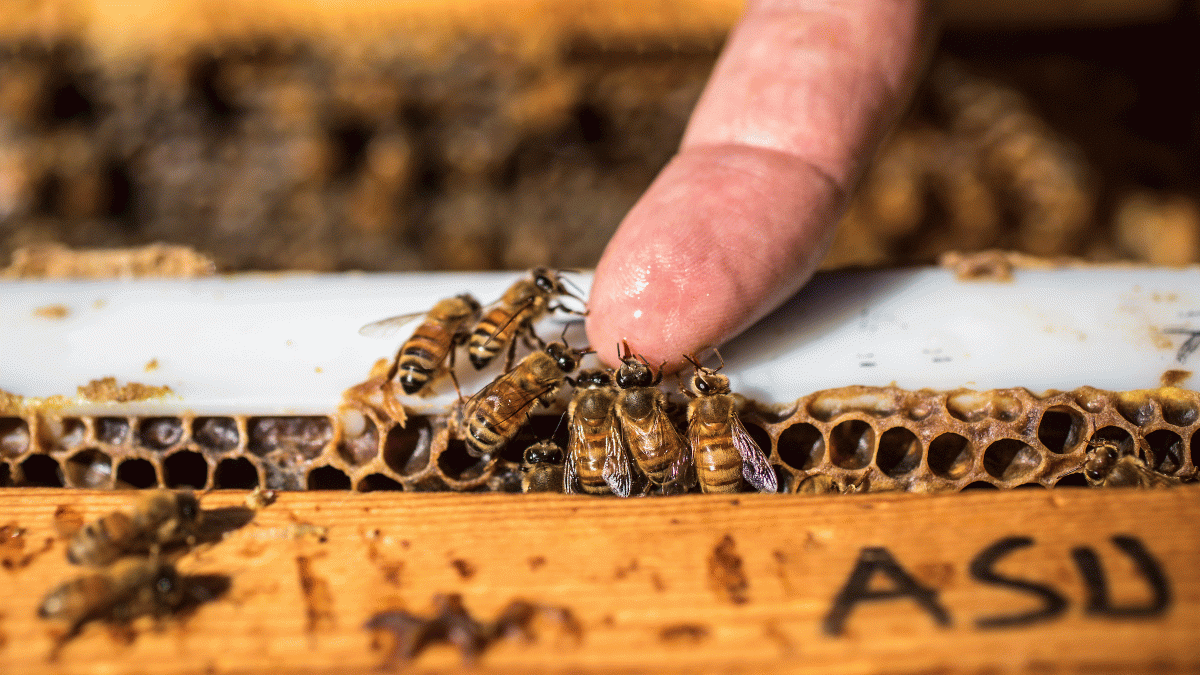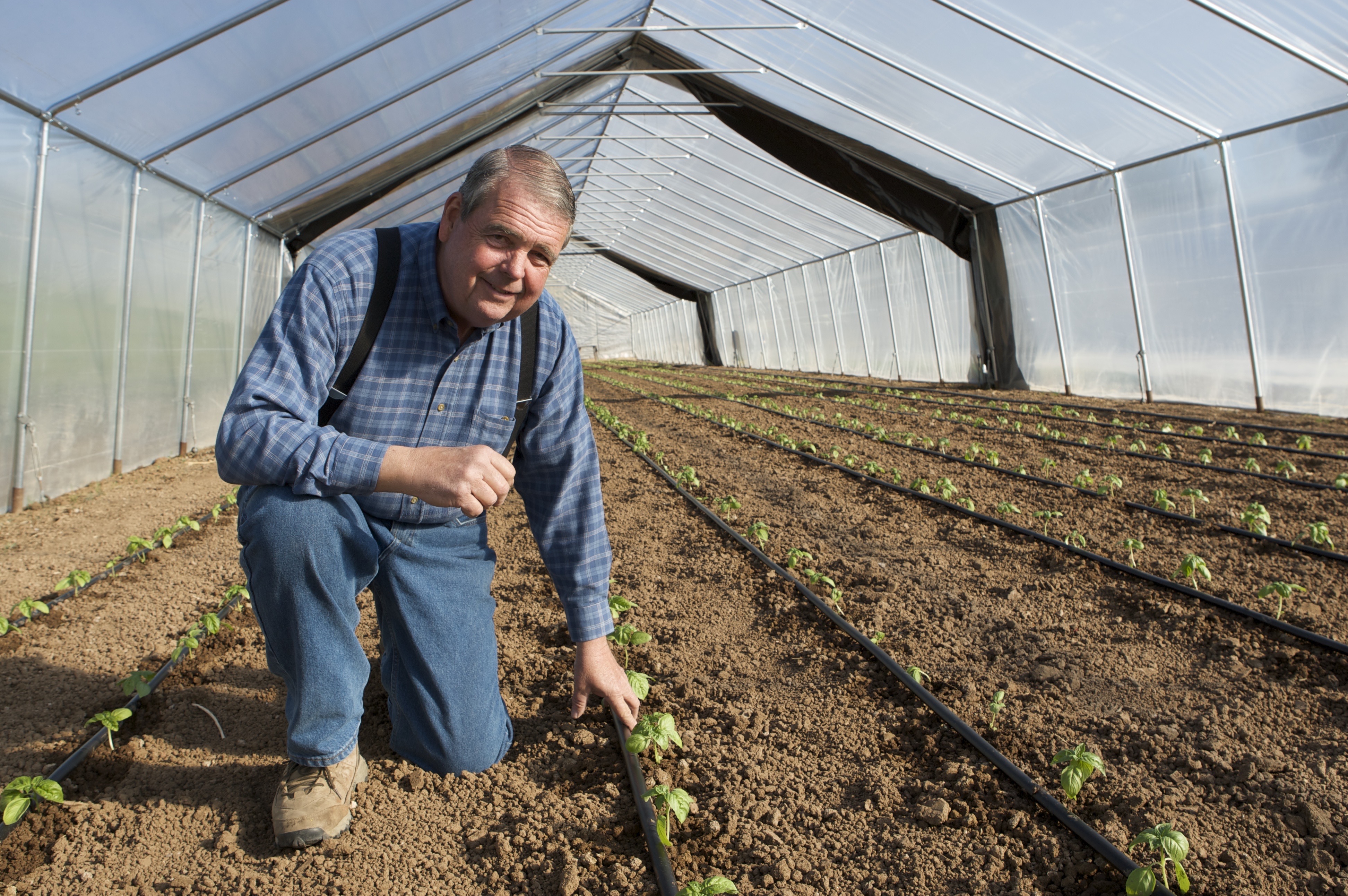When Robert Page walks through the 4 million honey bees housed at Arizona State University, he sees the potential to better understand how to survive tough living conditions. The Regents’ Professor also sees a way to build stronger immune systems.
Gro Amdam, a professor with the School of Life Sciences, considers the bees in 100 hives at ASU’s Honey Bee Research Lab as nature’s role models. “If everyone respected the environment like bees, we would all live in a better place.”
To the lab’s project manager and apiculturist, Osman Kaftanoglu, the bees offer a working blueprint on living efficiently and peacefully. “I wish we could act more like bees; thousands of hard workers who live close together in harmony.”
Although their research projects differ, ASU’s bee scientists share goals: turning research into cures for diseases, gaining a better understanding of human behavior and protecting crops by reversing the plague that has killed an alarming number of bees over the past decade.
“Our research is making contributions that make a lasting difference to bees and humans,” said Page, recognized as the world’s leading bee geneticist, who has authored more than 230 research articles, ranging from the division of labor in honey bee society to genetics and evolution of social organization.
A buzz-worthy lab
ASU Regents' Professor Robert Page calls his 2013 book, "The Spirit of the Hive: Mechanisms of Social Evolution," his opus to bees. Photo by Jarod Opperman/ASU
ASU began its honey bee research in earnest in 2004 when Page left his post as chair of the entomology department at the University of California, Davis to become founding director of the ASU School of Life Sciences.
Two years later, ASU opened its bee lab on the Polytechnic campus in Mesa, the largest of its kind in North America, that attracts visiting scientists from the U.S. and abroad.
Page — whose titles include provost emeritus and Foundation Chair of Life Sciences in the ASU College of Liberal Arts and Sciences — decided early on to devote his career to researching bees, and he has stayed true to his commitment for more than three decades, winning international accolades along the way.
But, for him, it’s the bee lab and its handful of researchers that deserve praise. Their discoveries are both vast and significant.
Led by Page, researchers found that bees that collect more protein-rich pollens and less carbohydrate-loaded nectar are healthier, and that selectively breeding the protein-consuming bees leads to healthier colonies.
ASU bee researchers helped discover that our own gut bacteria may contribute to the alarming antibiotic resistance to bacteria that causes disease. They also discovered that bees faced with short-term starvation when young adapt better to starvation as adults.
In a move to save the bees, researchers are studying how pesticides affect larvae and behavior. Other research is focused on preserving genetic stocks, artificial insemination of queen bees, territorial patterns and the widespread death of bees.
No one discovery alone is expected to reverse the spiraling death toll of bees and protect the food supply. But together they make a solution possible, or at least slow the spiraling decline.
“Research is always incremental, with pieces being added by all of us. There are so many things we can learn from bees,” said Page.
Food and human health
Farmer Bob McClendon says that keeping bees healthy is something everyone should be concerned with, because of their role in food production. Photo courtesy of McClendon Farm
To Bob McClendon, a farmer growing organic fruits and vegetables on 93 acres in greater Phoenix’s West Valley, the lab’s research into the alarming death of bees hopefully will help rebuild their ranks.
There were 5.5 million U.S. colonies in the 1950s, down to about 2.5 million today, researchers estimate. They blame a combination of pesticides, pollution, diseases, parasites and habitat destruction for the decline.
“Without bees, there simply would not be enough food to go around,” said McClendon, who first learned the importance of bees to agriculture decades ago as a college student working at a USDA-funded bee lab in Tucson.
In Arizona, these mega-pollinators support the harvesting of $7 billion in agriculture.
According to the Food and Agriculture Organization of the United Nations, of the 100 crops that account for 90 percent of the world’s food, 71 rely at least in part on bee pollination.
“Keeping bees alive and healthy is something we all should care about,” McClendon said. “Research gives us hope.”
In addition to keeping bees healthy, the ASU lab’s research zeros in on human health, searching for ways to protect against and cure diseases.
Take, for example, the research led by Brian Smith into learning and memory in both bees and humans. His work is being applied to studies of human diseases, including Alzheimer’s and Parkinson’s, along with the harmful effects of heavy metal poisoning on learning.
“Our work is with bees, but what we are learning will help humans in a very direct way,” said Smith, a behavior neuroscientist who is an ASU Trustee Professor in the School of Life Sciences and associate dean in the Graduate College.
Amdam also believes this to be true. The Norwegian biologist spends the lion’s share of her research time on how bees evolved from a solitary to a social state, how they age and ways to protect them against deadly diseases.
Her hopes are that the findings lead to cures for age-related diseases, or at least serve as a compass to point medical researchers in the right direction.
According to Amdam, bees age according to their role in the hive, not necessarily to how many days they have been alive. Those who leave the nest to gather pollen and nectar age quicker than the females who tend babies in the nest.
More importantly, research showed the brains of gatherers placed back in the hive to tend the babies rejuvenate, a sign that learning new tasks and nurturing young could be keys to living longer.
“Things we find true for bees can be true for us as well,” she said. “Maybe the elderly are better stimulated by interacting with babies than by playing computer games. Our findings with bees are inspiring new research on aging.”
ASU researchers also helped discover that bees and humans share a connection between sugar sensitivity, diabetic physiology and carbohydrate metabolism.
This, in turn, could lead to advancements in helping diabetics control blood sugar.
Lessons from bee society
Bees enter a hive through its base at ASU's Honey Bee Research Lab on the Polytechnic campus in Mesa. Photo by Charlie Leight/ASU Now
ASU researchers also study bees in hopes of learning how to make humans live together peacefully.
For this, researchers focus on the beehive and its colony, a miniature universe with order and purpose. Every colony consists of a single queen, hundreds of male drones and between 20,000 and 50,000 female worker bees.
Each bee has a specific role: the queen lays the eggs; the all-female workers forage food; and the male drones mate with the queen.
Amdam believes that research into the bees’ finely tuned social structure holds the potential to improve ours. “I hope what we do inspires people to understand nature, animals, plants and our roles in living together. Our research goes beyond health and happiness,” she said. “It can teach us how to respect the natural world.”
Kaftanoglu, who has been lab director from its inception, has spent four decades studying bees. One of his favorite lab responsibilities is hosting open-to-the public courses on beekeeping, including instruction on establishing hives and harvesting honey, beeswax and royal jelly.
He believes that healthy bees promote healthy communities.
This summer Kaftanoglu plans to retire, but not from bees. He will continue teaching beekeeping courses around the world.
“I find (bees) as interesting and important today as I did as a graduate student,” he said.
“And, for me, they bring peace. If I feel down or depressed, I just open the beehive and talk to the queen.”
Want to learn more?
ASU’s Ask A Biologist is an educational website that provides free stories, games, podcasts, classroom lessons and other resources to learners of all ages across the globe. In 2017, it had more than 12 million visits to the site, which also has a question feature where visitors can get their questions answered by biologists.
Among its bee resources:
- Bee dance game: Learn from the waggle dance how to find the best flowers. askabiologist.asu.edu/bee-dance-game
- Biology Bits: Bite-sized bee flashcards you can view on screen or download and print out. askabiologist.asu.edu/biology-bits/bee-bits
- Deeper dive: A multi-page story discussing the lives of honey bees. askabiologist.asu.edu/explore/honey-bees
- Bee brethren: Learn about the digger bee, common in central Arizona (askabiologist.asu.edu/explore/desert-digger-bees) and the perfume-seeking orchid bee (askabiologist.asu.edu/explore/orchid-bees).
Written by Karen Fernau; top photo by Charlie Leight/ASU Now. A version of this story appeared in the ASU Thrive magazine's spring issue.
More Science and technology

Indigenous geneticists build unprecedented research community at ASU
When Krystal Tsosie (Diné) was an undergraduate at Arizona State University, there were no Indigenous faculty she could look to in any science department. In 2022, after getting her PhD in genomics…

Pioneering professor of cultural evolution pens essays for leading academic journals
When Robert Boyd wrote his 1985 book “Culture and the Evolutionary Process,” cultural evolution was not considered a true scientific topic. But over the past half-century, human culture and cultural…

Lucy's lasting legacy: Donald Johanson reflects on the discovery of a lifetime
Fifty years ago, in the dusty hills of Hadar, Ethiopia, a young paleoanthropologist, Donald Johanson, discovered what would become one of the most famous fossil skeletons of our lifetime — the 3.2…



